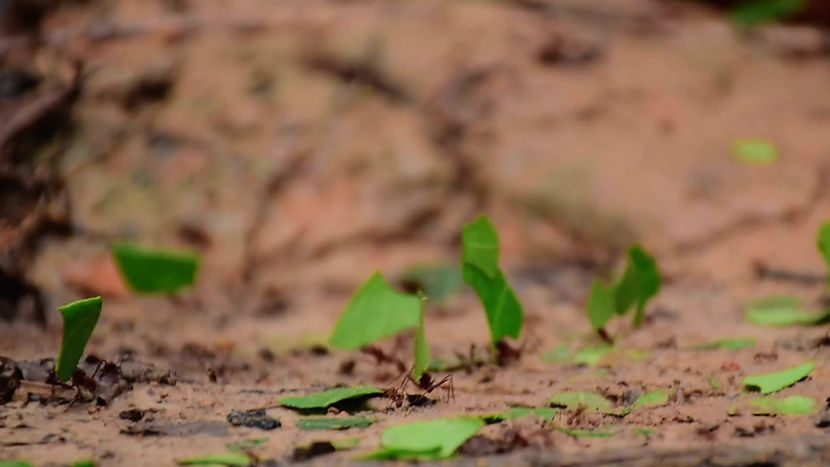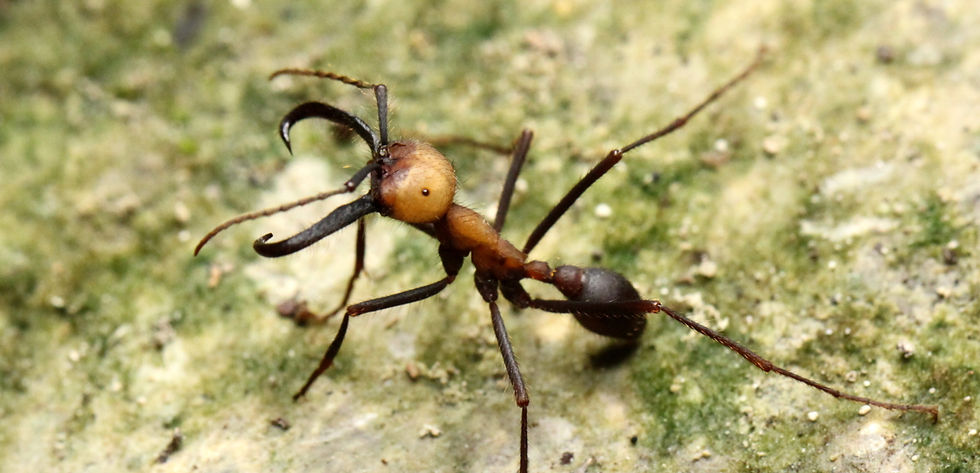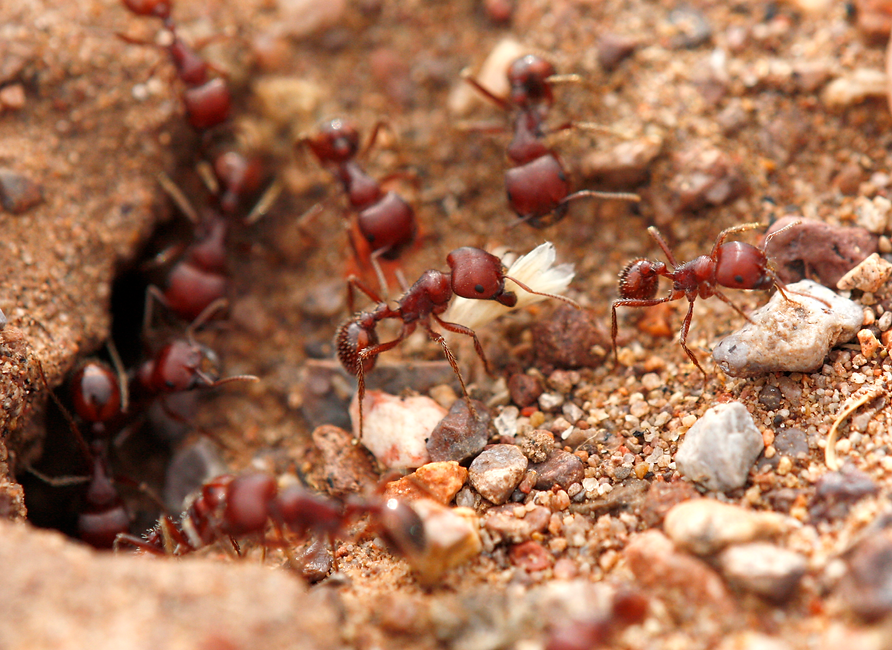
Despite their small sizes, ants are among the most fascinating creatures on Earth—complex, intelligent, and just amazing. Ants thrive in almost every part of our world, with over 14,000 species known to exist (and more being found regularly) (Bolton, 2023).

Purbayan Ghosh
PhD candidate, Arizona State University, USA
WRITTEN BY
From the arid Sahara to the tropical Amazon, from city parks to mountain peaks, these adaptable insects have developed an incredible range of forms and lifestyles. They cultivate their food, fight battles, construct enormous subterranean cities, and can even recognize diseases.
Ants are members of the family Formicidae, within the order Hymenoptera (which also contains their cousins: bees and wasps). Scientists classify ants into several major groups—from ancient, "primitive" types that resemble their wasp ancestors to the familiar household ants to the remarkable army ants that hunt in massive, well-coordinated swarms. In order to survive and thrive in different environments, each branch of the ant family tree has evolved unique adaptations (Ward, 2014; Moreau & Bell, 2013).

A Formica wood ant worker in California, part of a cooperative society of thousands. Photograph: Noa Pinter-Wollman

Nomadic army ants form some of the most spectacular 'superorganisms' on Earth. Here, an Eciton worker bares its vast mandibles in Guatemala. Photograph: Noa Pinter-Wollman
Tiny superpowers
Ants possess incredible strength despite their size—some can tolerate forces up to 5000 times their body weight (Nguyen, 2014). If humans had the same strength, they could lift over five fully loaded trucks overhead without sweat!! Speed is another superpower: if scaled up to human size, the Saharan silver ant can reach speeds of nearly 400 miles per hour (Pfeffer et al., 2019). They also operate in near-perfect harmony, producing organized colonies with specialized jobs, from builders and foragers to aggressive soldier ants armed with powerful jaws or venom that defend their nests (Hölldobler & Wilson, 1990).

Some ants are expert engineers. Leafcutter ants (Atta and Acromyrmex) cultivate underground fungus farms using freshly cut leaves, a farming practice that they have refined over millions of years (Schultz & Brady, 2008). Weaver ant workers (Oecophylla) build living chains to pull leaves together, while other workers carry larvae that produce silk threads to sew the leaves into weatherproof nests high in the canopy (Hölldobler & Wilson, 1983). In the event of flooding, fire ants (Solenopsis invicta) link their bodies to form floating rafts that can survive for weeks (Mlot et al., 2011). Others take cooperation to an extreme—when injured in battle, African Matabele ants (Megaponera analis) rescue and carry their wounded back to the nest to treat them, a behavior rarely seen in the insect world (Frank et al., 2017). Even more surprisingly, certain Formica fusca ants can use their acute sense of smell to detect cancer cells, potentially inspiring novel, non-invasive medical diagnostic techniques (Piqueret et al., 2022).
Dramatic strategies
Some ants are especially vicious. "Raider" ants invade neighboring colonies, stealing larvae and raising them as their own workers (Polyergus sp.) (Trager, 2013). The Southeast Asian exploding ants (Colobopsis explodens) take defense to an extreme. These so-called "kamikaze ants" rupture their bodies when threatened, unleashing a sticky, toxic material that immobilizes attackers (Laciny et al., 2018). This ultimate sacrifice protects their colony—a powerful reminder that ant colonies prioritize collective survival over individual life.

Vital ecosystem roles
Ants play a crucial role in ecosystems. They aid in soil aeration, seed dispersal (Levey & Byrne, 1993), nutrient recycling, and controlling insect populations (Philpott & Armbrecht, 2006). Without them, many ecosystems would struggle to function. Scientists even study ant traffic flow to improve highway designs and enhance autonomous vehicle algorithms (Guerrieri & Pugno, 2025).
These insects may be small, but their impact is enormous. Whether engaged in farming, fighting, rescuing, or even disease detection, ants never cease to astound and inspire. Next time you see one, take a closer look— you could be witnessing one of nature's greatest problem-solvers in action.
Harvester ants are fantastic seed dispersers. Here, Pogonomyrmex barbatus workers leave the nest in Arizona. Photograph: Noa Pinter-Wollman
Suggested reading
Ant research resources
Ant research is a huge and vibrant field of biology, ranging from ecosystem-level ecology to molecular biology. Here, we provide links to ongoing initiatives across ant research.
Genomics resources, including the Global Ant Genomics Alliance (GAGA) databases
The 'AntBase' database of ant systematics and taxonomy
'AntMaps' visualises the known geographical distributions of ants around the world
'AntWiki' provides a rich resource describing the biology of world's ants
References:
-
Bolton, B. (2023). An online catalog of the ants of the world. Available at: https://antcat.org
-
Ward, Philip S. The phylogeny and evolution of ants. Annual Review of Ecology, Evolution, and Systematics 45, no. 1 (2014): 23-43.
-
Moreau, Corrie S., and Charles D. Bell. Testing the museum versus cradle tropical biological diversity hypothesis: phylogeny, diversification, and ancestral biogeographic range evolution of the ants. Evolution 67, no. 8 (2013): 2240-2257.
-
Nguyen, Vienny, Blaine Lilly, and Carlos Castro. The exoskeletal structure and tensile loading behavior of an ant neck joint. Journal of Biomechanics 47, no. 2 (2014): 497-504.
-
Pfeffer, Sarah Elisabeth, Verena Luisa Wahl, Matthias Wittlinger, and Harald Wolf. High-speed locomotion in the Saharan silver ant, Cataglyphis bombycina. Journal of Experimental Biology 222, no. 20 (2019): jeb198705.
-
Hölldobler, Bert, and Edward O. Wilson. The Ants. Harvard University Press, 1990.
-
Schultz, Ted R., and Seán G. Brady. Major evolutionary transitions in ant agriculture. Proceedings of the National Academy of Sciences 105, no. 14 (2008): 5435-5440.
-
Hölldobler, Bert, and Edward O. Wilson. The evolution of communal nest-weaving in ants: Steps that may have led to a complicated form of cooperation in weaver ants can be inferred from less advanced behavior in other species. American Scientist 71, no. 5 (1983): 490-499.
-
Mlot, Nathan J., Craig A. Tovey, and David L. Hu. Fire ants self-assemble into waterproof rafts to survive floods. Proceedings of the National Academy of Sciences 108, no. 19 (2011): 7669-7673.
-
Frank, Erik Thomas, Thomas Schmitt, Thomas Hovestadt, Oliver Mitesser, Jonas Stiegler, and Karl Eduard Linsenmair. Saving the injured: Rescue behavior in the termite-hunting ant Megaponera analis. Science Advances 3, no. 4 (2017): e1602187.
-
Piqueret, Baptiste, Brigitte Bourachot, Chloé Leroy, Paul Devienne, Fatima Mechta-Grigoriou, Patrizia d’Ettorre, and Jean-Christophe Sandoz. Ants detect cancer cells through volatile organic compounds. iScience 25, no. 3 (2022).
-
Trager, James C. Global revision of the dulotic ant genus Polyergus (Hymenoptera: Formicidae, Formicinae, Formicini). Zootaxa 3722, no. 4 (2013): 501-548.
-
Laciny, Alice, Herbert Zettel, Alexey Kopchinskiy, Carina Pretzer, Anna Pal, Kamariah Abu Salim, Mohammad Javad Rahimi et al. Colobopsis explodens sp. n., model species for studies on “exploding ants”(Hymenoptera, Formicidae), with biological notes and first illustrations of males of the Colobopsis cylindrica group. ZooKeys 751 (2018): 1.
-
Levey, Douglas J., and Margaret M. Byrne. Complex ant‐plant interactions: rain‐forest ants as secondary dispersers and post‐dispersal seed predators. Ecology 74, no. 6 (1993): 1802-1812.
-
Philpott, Stacy M., and Inge Armbrecht. Biodiversity in tropical agroforests and the ecological role of ants and ant diversity in predatory function. Ecological Entomology 31, no. 4 (2006): 369-377.
-
Guerrieri, Marco, and Nicola Pugno. ANTi-JAM solutions for smart roads: Ant-inspired traffic flow rules under CAVs environment. Transportation Research Interdisciplinary Perspectives 29 (2025): 101331.
